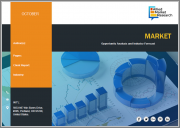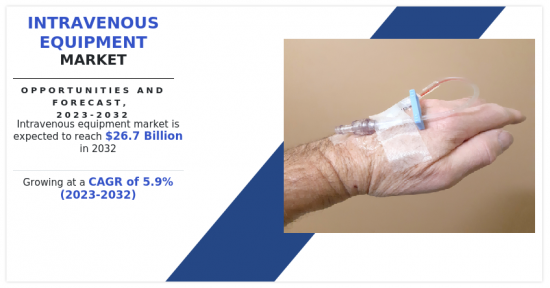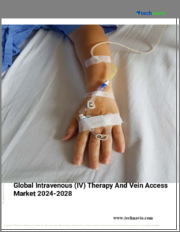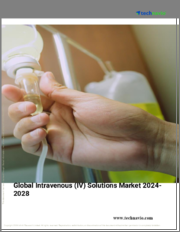
|
시장보고서
상품코드
1365617
정맥내 장비 시장 : 제품 유형별, 최종사용자별 - 세계 기회 분석과 산업 예측(2023-2032년)Intravenous Equipment Market By Product Type (IV catheters, Infusion pumps, Administration sets, Needleless connectors, Others), By End User (Hospitals & clinics, Homecare settings, Others): Global Opportunity Analysis & Industry Forecast, 2023-2032 |
||||||
Allied Market Research의 최신 리포트 '정맥내 장비 시장'에 따르면 정맥내 장비 시장은 2022년에 150억 달러로 평가되며, 2023-2032년 CAGR 5.9%로 성장하며, 2032년에는 267억 달러에 달할 것으로 추정되고 있습니다.

정맥 내(IV) 장비는 정맥내 요법에 사용되는 기구 및 장비를 말하며, 정맥을 통해 환자의 혈류에 직접적으로 수분, 약물 및 영양분을 공급하는 의료 절차를 말합니다. 정맥주사는 수분 보충, 약물 투여, 수혈, 영양 공급 등 다양한 목적으로 일반적으로 시행되고 있습니다. 정맥내 장비의 예로는 정맥에 삽입하여 접근성을 확보하는 바늘과 카테터, 정맥주사 가방이나 용기와 환자를 연결하는 유연한 튜브, 유량을 제어하고 조절하여 정확한 주입을 보장하는 전자기기인 수액 펌프 등이 있습니다.
정맥내 장비 시장의 성장을 가속하는 주요 요인은 만성질환을 앓고 있는 사람들 증가, 노인 인구 증가, 정맥내 장비 기술의 지속적인 발전입니다. 정맥주사 요법에 대한 수요는 암, 당뇨병, 심혈관 질환, 감염성 질환과 같은 만성질환의 발병률 증가에 기인합니다. 정맥투여는 약물, 수액, 영양을 직접적이고 효율적으로 투여할 수 있으므로 만성질환 환자들에게 매우 중요한 치료법이 되고 있습니다. 또한 세계 인구구조가 크게 변화하면서 노인 인구가 빠르게 증가하고 있습니다. 노인들은 만성질환에 걸리기 쉽고, 잦은 입원 및 치료가 필요합니다. 수액 요법은 노인 환자에게 지지 요법을 제공하는 데 중요한 역할을 하고 있습니다. 이처럼 노인 인구 증가는 정맥내 장비 시장의 성장에 기여하고 있습니다.
또한 정맥내 장비 기술의 지속적인 발전으로 정맥주사 치료의 안전성, 정확성 및 사용 편의성이 향상되고 있습니다. 스마트 주입 펌프, 통합 연결 솔루션, 무침 주입 시스템 등의 혁신은 약물전달의 효율성과 정확성을 향상시키고, 투약 오류의 위험을 줄이며, 환자 치료 결과를 개선했습니다. 또한 의료 전문가와 환자들 사이에서 약물 흡수 촉진, 정확한 약물전달, 환자 순응도 향상 등 정맥내 치료의 이점에 대한 인식이 높아지고 있습니다. 이에 따라 정맥내 요법을 치료 계획에 도입하는 의료진들이 늘어나면서 정맥내 장비에 대한 수요가 증가하고 있습니다.
또한 많은 국가들이 의료 및 인프라를 강화하고 양질의 의료 서비스에 대한 접근성을 강화하기 위해 많은 자금을 투자하고 있으며, 의료 지출은 지속적으로 증가하고 있습니다. 이러한 의료 지출 증가는 고급 환자 치료에 대한 수요 증가에 대응하기 위해 정맥내 장비를 포함한 필수 의료기기 조달을 포함하며 시장 성장을 가속하고 있습니다. 또한 응급실과 중환자실은 환자를 신속하게 안정시키고 생명을 구하는 약물과 수액을 투여하기 위해 정맥내 치료에 의존하는 경우가 많아졌습니다. 세계에서 응급의료 및 외상 발생 건수 증가는 이러한 환경에서 정맥내 장비에 대한 수요 증가에 큰 기여를 하고 있습니다. 정맥내 장비는 중요한 치료를 신속하고 효율적으로 수행하여 중환자실에서 환자의 최적의 치료 결과를 보장하는 데 중요한 역할을 합니다.
정맥내 장비 시장은 제품 유형, 최종사용자, 지역으로 분류됩니다. 제품 유형에 따라 시장은 정맥 카테터, 주입 펌프, 투여 세트, 니들리스 커넥터, 기타로 분류됩니다. 또한 투약 세트는 용액 투약 세트와 혈액 투약 세트로 분류됩니다. 최종사용자에 따라서는 병원 및 클리닉, 재택의료, 기타로 분류됩니다. 지역별로는 북미(미국, 캐나다, 멕시코), 유럽(독일, 프랑스, 영국, 이탈리아, 스페인, 기타 유럽), 아시아태평양(일본, 중국, 호주, 인도, 한국, 기타 아시아태평양), 아시아태평양(브라질, 중국, 아랍, 호주, 인도, 한국, 기타 아시아태평양)으로 나뉩니다, 인도, 한국, 기타 아시아태평양)로 분석됩니다. 세계 정맥내 장비 시장에서 활동하는 주요 기업으로는 Becton, Dickinson and Company, B. Braun SE, ICU Medical, Inc, 3M Company, AngioDynamics, Inc., Terumo Corporation, Poly Medicure Ltd. 주요 기업은 제품 포트폴리오를 확장하기 위해 제품 승인 및 인수 등의 전략을 채택하고 있습니다.
목차
제1장 서론
제2장 주요 요약
제3장 시장 개요
- 시장의 정의와 범위
- 주요 조사 결과
- 영향요인
- 주요 투자 기회
- Porter's Five Forces 분석
- 시장 역학
- 촉진요인
- 정맥 내장비의 기술적 진보
- 외과수술 건수의 증가
- 만성질환의 증가
- 억제요인
- 엄격한 규제 요건
- 기회
- 신흥 시장에서 성장 기회
- 촉진요인
- COVID-19 시장에 대한 영향 분석
제4장 정맥내 장비 시장 : 제품 유형별
- 개요
- 수액 카테터
- 주입 펌프
- 투여 세트
- 투여 세트 정맥내 장비 시장 : 세트 유형별
- 니들리스 커넥터
- 기타
제5장 정맥내 장비 시장 : 최종사용자별
- 개요
- 병원 및 클리닉
- 재택의료
- 기타
제6장 정맥내 장비 시장 : 지역별
- 개요
- 북미
- 미국
- 캐나다
- 멕시코
- 유럽
- 독일
- 프랑스
- 영국
- 이탈리아
- 스페인
- 기타
- 아시아태평양
- 일본
- 중국
- 인도
- 호주
- 한국
- 기타
- 라틴아메리카·중동 및 아프리카
- 브라질
- 사우디아라비아
- 남아프리카공화국
- 기타
제7장 경쟁 구도
- 서론
- 주요 성공 전략
- 주요 10사의 제품 매핑
- 경쟁 대시보드
- 경쟁 히트맵
- 주요 기업의 포지셔닝, 2022년
제8장 기업 개요
- Becton, Dickinson and Company
- B. Braun SE
- ICU Medical, Inc.
- Baxter International Inc.
- Teleflex Incorporated.
- 3M Company
- AngioDynamics, Inc.
- Terumo Corporation
- Poly Medicure Ltd.
- Vygon
According to a new report published by Allied Market Research, titled, "Intravenous Equipment Market," The intravenous equipment market was valued at $15.0 billion in 2022, and is estimated to reach $26.7 billion by 2032, growing at a CAGR of 5.9% from 2023 to 2032.

Intravenous (IV) equipment refers to the tools and devices used in intravenous therapy, a medical procedure that involves delivering fluids, medications, or nutrients directly into a patient's bloodstream through a vein. IV therapy is commonly used for various purposes, including hydration, administering medications, blood transfusions and nutritional support. Examples of intravenous equipment include needles or catheters that are inserted into a vein to create access, flexible tubing's that connects the IV bag or container to the patient and infusion pumps are electronic devices that control and regulate the flow rate, ensuring precise delivery.
The major factors driving the growth of the intravenous equipment market are the increase in number of people suffering from chronic conditions, rise in geriatric population, and continuous advancements in IV equipment technology. The demand for IV therapy is driven by the rising incidence of chronic diseases such cancer, diabetes, cardiovascular problems, and infectious diseases. Intravenous administration allows for the direct and efficient delivery of medications, fluids and nutrition, making it a crucial treatment method for patients with chronic conditions. In addition, world's population is experiencing a significant demographic shift, with a rapidly growing elderly population. The elderly people are more prone to developing chronic illnesses, which necessitate frequent hospital stays and medical treatment. IV therapy plays a vital role in providing supportive care to geriatric patients. Thus, the increasing geriatric population is contributing to the growth of the intravenous equipment market.
Further, continuous advancements in intravenous equipment technology have improved safety, precision and ease of use in administering intravenous therapy. Innovations such as smart infusion pumps, integrated connectivity solutions and needleless IV systems have enhanced the efficiency and accuracy of drug delivery, reduced the risk of medication errors and improved patient outcomes. Furthermore, growing awareness about the benefits of intravenous therapy, such as faster drug absorption, precise medication delivery and improved patient compliance, has increased among healthcare professionals and patients. Thus, more medical practitioners are incorporating IV therapy into their treatment plans, leading to a higher demand for intravenous equipment.
Additionally, as many nations invest more funds in enhancing healthcare infrastructure and boosting access to high-quality medical services, healthcare spending keeps rising. This increased healthcare spending encompasses the procurement of essential medical equipment, including IV equipment, to meet the growing demand for advanced patient care, thereby propelling the market growth. In addition, emergency departments and critical care units frequently rely on IV therapy to stabilize patients quickly and administer life-saving medications or fluids. The rising number of emergency care cases and trauma incidents worldwide has significantly contributed to the demand for IV equipment in these settings. IV equipment plays a vital role in delivering essential treatments promptly and efficiently, ensuring optimal patient outcomes in critical care scenarios.
The intravenous equipment market is segmented into product type, end user, and region. On the basis of product type, the market is categorized into IV catheters, infusion pumps, administration sets, needleless connectors, and others. Further, administration sets are classified into solution administration sets and blood administration sets. On the basis of end user, the market is segregated into hospital and clinics, homecare settings and others. Region wise, the market is analyzed across North America (the U.S., Canada, and Mexico), Europe (Germany, France, the UK, Italy, Spain, and rest of Europe), Asia-Pacific (Japan, China, Australia, India, South Korea, and rest of Asia-Pacific), and LAMEA (Brazil, South Africa, Saudi Arabia, and rest of LAMEA). Major key players that operate in the global intravenous equipment market are Becton, Dickinson and Company, B. Braun SE, ICU Medical, Inc., vygon, Baxter International Inc., Teleflex Incorporated., 3M Company, AngioDynamics, Inc., Terumo Corporation and Poly Medicure Ltd. The key players have adopted strategy such as product approval and acquisition to expand their product portfolio.
Key Benefits For Stakeholders
- This report provides a quantitative analysis of the market segments, current trends, estimations, and dynamics of the intravenous equipment market analysis from 2022 to 2032 to identify the prevailing intravenous equipment market opportunities.
- The market research is offered along with information related to key drivers, restraints, and opportunities.
- Porter's five forces analysis highlights the potency of buyers and suppliers to enable stakeholders make profit-oriented business decisions and strengthen their supplier-buyer network.
- In-depth analysis of the intravenous equipment market segmentation assists to determine the prevailing market opportunities.
- Major countries in each region are mapped according to their revenue contribution to the global market.
- Market player positioning facilitates benchmarking and provides a clear understanding of the present position of the market players.
- The report includes the analysis of the regional as well as global intravenous equipment market trends, key players, market segments, application areas, and market growth strategies.
Additional benefits you will get with this purchase are:
- Quarterly Update and* (only available with a corporate license, on listed price)
- 5 additional Company Profile of client Choice pre- or Post-purchase, as a free update.
- Free Upcoming Version on the Purchase of Five and Enterprise User License.
- 16 analyst hours of support* (post-purchase, if you find additional data requirements upon review of the report, you may receive support amounting to 16 analyst hours to solve questions, and post-sale queries)
- 15% Free Customization* (in case the scope or segment of the report does not match your requirements, 20% is equivalent to 3 working days of free work, applicable once)
- Free data Pack on the Five and Enterprise User License. (Excel version of the report)
- Free Updated report if the report is 6-12 months old or older.
- 24-hour priority response*
- Free Industry updates and white papers.
Possible Customization with this report (with additional cost and timeline talk to the sales executive to know more)
- Regulatory Guidelines
- Additional company profiles with specific to client's interest
- Additional country or region analysis- market size and forecast
- Expanded list for Company Profiles
- Historic market data
- SWOT Analysis
Key Market Segments
By Product Type
- IV catheters
- Infusion pumps
- Administration sets
- Type of set
- Solution administration sets
- Blood administration sets.
- Needleless connectors
- Others
By End User
- Hospitals and clinics
- Homecare settings
- Others
By Region
- North America
- U.S.
- Canada
- Mexico
- Europe
- Germany
- France
- UK
- Italy
- Spain
- Rest of Europe
- Asia-Pacific
- Japan
- China
- India
- Australia
- South Korea
- Rest of Asia-Pacific
- LAMEA
- Brazil
- Saudi Arabia
- South Africa
- Rest of LAMEA
Key Market Players:
- AngioDynamics, Inc.
- Becton, Dickinson and Company
- Vygon
- 3M Company
- Terumo Corporation
- Poly Medicure Ltd.
- B. Braun SE
- ICU Medical, Inc.
- Baxter International Inc.
- Teleflex Incorporated.
TABLE OF CONTENTS
CHAPTER 1: INTRODUCTION
- 1.1. Report description
- 1.2. Key market segments
- 1.3. Key benefits to the stakeholders
- 1.4. Research Methodology
- 1.4.1. Primary research
- 1.4.2. Secondary research
- 1.4.3. Analyst tools and models
CHAPTER 2: EXECUTIVE SUMMARY
- 2.1. CXO Perspective
CHAPTER 3: MARKET OVERVIEW
- 3.1. Market definition and scope
- 3.2. Key findings
- 3.2.1. Top impacting factors
- 3.2.2. Top investment pockets
- 3.3. Porter's five forces analysis
- 3.3.1. High bargaining power of suppliers
- 3.3.2. Moderate threat of new entrants
- 3.3.3. Moderate threat of substitutes
- 3.3.4. Low intensity of rivalry
- 3.3.5. High bargaining power of buyers
- 3.4. Market dynamics
- 3.4.1. Drivers
- 3.4.1.1. Technological advancements in intravenous equipment
- 3.4.1.2. Growing number of surgical procedures
- 3.4.1.3. Growing prevalence of chronic diseases
- 3.4.1. Drivers
- 3.4.2. Restraints
- 3.4.2.1. Stringent regulatory requirements
- 3.4.3. Opportunities
- 3.4.3.1. Growth opportunities in emerging markets
- 3.5. COVID-19 Impact Analysis on the market
CHAPTER 4: INTRAVENOUS EQUIPMENT MARKET, BY PRODUCT TYPE
- 4.1. Overview
- 4.1.1. Market size and forecast
- 4.2. IV catheters
- 4.2.1. Key market trends, growth factors and opportunities
- 4.2.2. Market size and forecast, by region
- 4.2.3. Market share analysis by country
- 4.3. Infusion pumps
- 4.3.1. Key market trends, growth factors and opportunities
- 4.3.2. Market size and forecast, by region
- 4.3.3. Market share analysis by country
- 4.4. Administration sets
- 4.4.1. Key market trends, growth factors and opportunities
- 4.4.2. Market size and forecast, by region
- 4.4.3. Market share analysis by country
- 4.4.4. Administration sets Intravenous Equipment Market by Type of set
- 4.5. Needleless connectors
- 4.5.1. Key market trends, growth factors and opportunities
- 4.5.2. Market size and forecast, by region
- 4.5.3. Market share analysis by country
- 4.6. Others
- 4.6.1. Key market trends, growth factors and opportunities
- 4.6.2. Market size and forecast, by region
- 4.6.3. Market share analysis by country
CHAPTER 5: INTRAVENOUS EQUIPMENT MARKET, BY END USER
- 5.1. Overview
- 5.1.1. Market size and forecast
- 5.2. Hospitals and clinics
- 5.2.1. Key market trends, growth factors and opportunities
- 5.2.2. Market size and forecast, by region
- 5.2.3. Market share analysis by country
- 5.3. Homecare settings
- 5.3.1. Key market trends, growth factors and opportunities
- 5.3.2. Market size and forecast, by region
- 5.3.3. Market share analysis by country
- 5.4. Others
- 5.4.1. Key market trends, growth factors and opportunities
- 5.4.2. Market size and forecast, by region
- 5.4.3. Market share analysis by country
CHAPTER 6: INTRAVENOUS EQUIPMENT MARKET, BY REGION
- 6.1. Overview
- 6.1.1. Market size and forecast By Region
- 6.2. North America
- 6.2.1. Key trends and opportunities
- 6.2.2. Market size and forecast, by Product Type
- 6.2.3. Market size and forecast, by End User
- 6.2.4. Market size and forecast, by country
- 6.2.4.1. U.S.
- 6.2.4.1.1. Key market trends, growth factors and opportunities
- 6.2.4.1.2. Market size and forecast, by Product Type
- 6.2.4.1.3. Market size and forecast, by End User
- 6.2.4.2. Canada
- 6.2.4.2.1. Key market trends, growth factors and opportunities
- 6.2.4.2.2. Market size and forecast, by Product Type
- 6.2.4.2.3. Market size and forecast, by End User
- 6.2.4.3. Mexico
- 6.2.4.3.1. Key market trends, growth factors and opportunities
- 6.2.4.3.2. Market size and forecast, by Product Type
- 6.2.4.3.3. Market size and forecast, by End User
- 6.3. Europe
- 6.3.1. Key trends and opportunities
- 6.3.2. Market size and forecast, by Product Type
- 6.3.3. Market size and forecast, by End User
- 6.3.4. Market size and forecast, by country
- 6.3.4.1. Germany
- 6.3.4.1.1. Key market trends, growth factors and opportunities
- 6.3.4.1.2. Market size and forecast, by Product Type
- 6.3.4.1.3. Market size and forecast, by End User
- 6.3.4.2. France
- 6.3.4.2.1. Key market trends, growth factors and opportunities
- 6.3.4.2.2. Market size and forecast, by Product Type
- 6.3.4.2.3. Market size and forecast, by End User
- 6.3.4.3. UK
- 6.3.4.3.1. Key market trends, growth factors and opportunities
- 6.3.4.3.2. Market size and forecast, by Product Type
- 6.3.4.3.3. Market size and forecast, by End User
- 6.3.4.4. Italy
- 6.3.4.4.1. Key market trends, growth factors and opportunities
- 6.3.4.4.2. Market size and forecast, by Product Type
- 6.3.4.4.3. Market size and forecast, by End User
- 6.3.4.5. Spain
- 6.3.4.5.1. Key market trends, growth factors and opportunities
- 6.3.4.5.2. Market size and forecast, by Product Type
- 6.3.4.5.3. Market size and forecast, by End User
- 6.3.4.6. Rest of Europe
- 6.3.4.6.1. Key market trends, growth factors and opportunities
- 6.3.4.6.2. Market size and forecast, by Product Type
- 6.3.4.6.3. Market size and forecast, by End User
- 6.4. Asia-Pacific
- 6.4.1. Key trends and opportunities
- 6.4.2. Market size and forecast, by Product Type
- 6.4.3. Market size and forecast, by End User
- 6.4.4. Market size and forecast, by country
- 6.4.4.1. Japan
- 6.4.4.1.1. Key market trends, growth factors and opportunities
- 6.4.4.1.2. Market size and forecast, by Product Type
- 6.4.4.1.3. Market size and forecast, by End User
- 6.4.4.2. China
- 6.4.4.2.1. Key market trends, growth factors and opportunities
- 6.4.4.2.2. Market size and forecast, by Product Type
- 6.4.4.2.3. Market size and forecast, by End User
- 6.4.4.3. India
- 6.4.4.3.1. Key market trends, growth factors and opportunities
- 6.4.4.3.2. Market size and forecast, by Product Type
- 6.4.4.3.3. Market size and forecast, by End User
- 6.4.4.4. Australia
- 6.4.4.4.1. Key market trends, growth factors and opportunities
- 6.4.4.4.2. Market size and forecast, by Product Type
- 6.4.4.4.3. Market size and forecast, by End User
- 6.4.4.5. South Korea
- 6.4.4.5.1. Key market trends, growth factors and opportunities
- 6.4.4.5.2. Market size and forecast, by Product Type
- 6.4.4.5.3. Market size and forecast, by End User
- 6.4.4.6. Rest of Asia-Pacific
- 6.4.4.6.1. Key market trends, growth factors and opportunities
- 6.4.4.6.2. Market size and forecast, by Product Type
- 6.4.4.6.3. Market size and forecast, by End User
- 6.5. LAMEA
- 6.5.1. Key trends and opportunities
- 6.5.2. Market size and forecast, by Product Type
- 6.5.3. Market size and forecast, by End User
- 6.5.4. Market size and forecast, by country
- 6.5.4.1. Brazil
- 6.5.4.1.1. Key market trends, growth factors and opportunities
- 6.5.4.1.2. Market size and forecast, by Product Type
- 6.5.4.1.3. Market size and forecast, by End User
- 6.5.4.2. Saudi Arabia
- 6.5.4.2.1. Key market trends, growth factors and opportunities
- 6.5.4.2.2. Market size and forecast, by Product Type
- 6.5.4.2.3. Market size and forecast, by End User
- 6.5.4.3. South Africa
- 6.5.4.3.1. Key market trends, growth factors and opportunities
- 6.5.4.3.2. Market size and forecast, by Product Type
- 6.5.4.3.3. Market size and forecast, by End User
- 6.5.4.4. Rest of LAMEA
- 6.5.4.4.1. Key market trends, growth factors and opportunities
- 6.5.4.4.2. Market size and forecast, by Product Type
- 6.5.4.4.3. Market size and forecast, by End User
CHAPTER 7: COMPETITIVE LANDSCAPE
- 7.1. Introduction
- 7.2. Top winning strategies
- 7.3. Product Mapping of Top 10 Player
- 7.4. Competitive Dashboard
- 7.5. Competitive Heatmap
- 7.6. Top player positioning, 2022
CHAPTER 8: COMPANY PROFILES
- 8.1. Becton, Dickinson and Company
- 8.1.1. Company overview
- 8.1.2. Key Executives
- 8.1.3. Company snapshot
- 8.1.4. Operating business segments
- 8.1.5. Product portfolio
- 8.1.6. Business performance
- 8.2. B. Braun SE
- 8.2.1. Company overview
- 8.2.2. Key Executives
- 8.2.3. Company snapshot
- 8.2.4. Operating business segments
- 8.2.5. Product portfolio
- 8.2.6. Business performance
- 8.3. ICU Medical, Inc.
- 8.3.1. Company overview
- 8.3.2. Key Executives
- 8.3.3. Company snapshot
- 8.3.4. Operating business segments
- 8.3.5. Product portfolio
- 8.3.6. Business performance
- 8.3.7. Key strategic moves and developments
- 8.4. Baxter International Inc.
- 8.4.1. Company overview
- 8.4.2. Key Executives
- 8.4.3. Company snapshot
- 8.4.4. Operating business segments
- 8.4.5. Product portfolio
- 8.4.6. Business performance
- 8.4.7. Key strategic moves and developments
- 8.5. Teleflex Incorporated.
- 8.5.1. Company overview
- 8.5.2. Key Executives
- 8.5.3. Company snapshot
- 8.5.4. Operating business segments
- 8.5.5. Product portfolio
- 8.5.6. Business performance
- 8.6. 3M Company
- 8.6.1. Company overview
- 8.6.2. Key Executives
- 8.6.3. Company snapshot
- 8.6.4. Operating business segments
- 8.6.5. Product portfolio
- 8.6.6. Business performance
- 8.7. AngioDynamics, Inc.
- 8.7.1. Company overview
- 8.7.2. Key Executives
- 8.7.3. Company snapshot
- 8.7.4. Operating business segments
- 8.7.5. Product portfolio
- 8.7.6. Business performance
- 8.8. Terumo Corporation
- 8.8.1. Company overview
- 8.8.2. Key Executives
- 8.8.3. Company snapshot
- 8.8.4. Operating business segments
- 8.8.5. Product portfolio
- 8.8.6. Business performance
- 8.9. Poly Medicure Ltd.
- 8.9.1. Company overview
- 8.9.2. Key Executives
- 8.9.3. Company snapshot
- 8.9.4. Operating business segments
- 8.9.5. Product portfolio
- 8.9.6. Business performance
- 8.10. Vygon
- 8.10.1. Company overview
- 8.10.2. Key Executives
- 8.10.3. Company snapshot
- 8.10.4. Operating business segments
- 8.10.5. Product portfolio



















